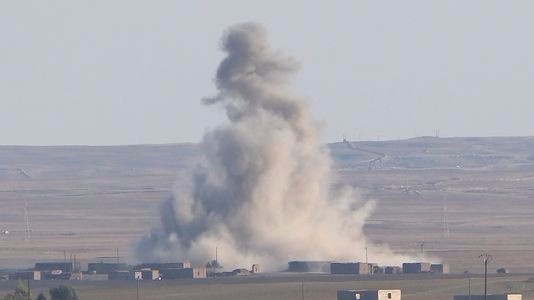Suicide — not combat — is the leading killer of U.S. troops deployed to the Middle East to fight Islamic State militants, according to newly released Pentagon statistics.
U.S. casualties have been relatively low since the U.S.-led war effort began with a bombing campaign in August 2014, reflecting the limited combat exposure for troops. Of the 31 troops who have died as of Dec. 27 in Operation Inherent Resolve, 11 have taken their own lives. Eight died in combat, seven in accidents and four succumbed to illness or injury. The cause of one death is under investigation.
The reasons suicide ranks as the No. 1 cause of troop deaths are complex and poorly understood, according to experts on military suicide. They likely include mental illnesses that enlistees brought with them to boot camp, post-traumatic stress, multiple combat deployments and heightened anxiety in a military at war for 16 years.
“I don’t think there’s one single cause for it,” said Rajeev Ramchand, a senior behavioral scientist at the Rand Corp. who has studied military suicide. “There are a multitude of factors. They are also picking up on a trend toward more suicide in the U.S. population as a whole. Maybe there’s a universal stress on everyone in the military that affects them in profound ways.”
Read more:
The nature of the fight against ISIL has also limited combat fatalities. Direct fights between U.S. troops and ISIL fighters are uncommon events. U.S.-led airstrikes have been the principal means of attack, and they have been exceptionally lethal. The military estimates bombs and missiles fired by warplanes and drones have killed 50,000 ISIL fighters.
Thousands of American troops have deployed to train and assist Iraq’s army, and thousands more have been sent to provide security, launch artillery barrages and perform logistics duties. Few of them have come under direct attack.
Several hundred more U.S. commandos are on the ground in Iraq and Syria, conducting raids to capture or kill ISIL leaders and assist local fighters. Some of those missions have been deadly. On Oct. 22, 2015, Master Sgt. Joshua Wheeler, a member of the Army’s super-elite Delta Force, was killed by gunfire as he helped free 70 prisoners from an ISIL prison in northern Iraq.
The largest loss of life in a single incident in the war against ISIL didn’t take place in Iraq or Syria. It occurred in Jordan on Nov. 4, 2016, when three Special Forces soldiers were shot by a guard as they tried to enter an air base. The American commandos were training local forces to fight ISIL militants. Their shooting deaths remain under investigation.
The most casualties in a single attack occurred earlier this year when rockets fired by ISIL fighters targeted a Marine artillery base in northern Iraq. The attack on March 19 killed Staff Sgt. Louis Cardin and wounded eight others. All of them received Purple Heart medals, according to the Navy.
By far, 2016 has been the most dangerous for U.S. forces since the war began. Seven of the eight combat deaths have occurred in 2016, and 21 of the 26 troops wounded in action suffered their injuries this year.
But the military's suicide problem continues.
Between 2001 and 2010, the rate of suicide in the military doubled, Ramchand said. The chief spike occurred around 2005 when fighting and combat deaths soared in Iraq and Afghanistan, and the Army shouldered most of the war’s burden.
The Army still has the highest percentage among the services for suicide, according to the Pentagon's latest figures. Of the 269 active-duty troops who took their own lives in 2014, 122 were soldiers, or about 28%.
As a whole, the military’s rate of suicide of about 20 per 100,000 troops in 2014 was comparable to the same civilian population.
Retired general Peter Chiarelli made suicide prevention a top priority when he was the Army’s No. 2 officer as vice chief of staff from 2008 to 2012. He expressed frustration with the failure to drive down the rate of military and civilian suicides.
He called for a research effort, similar to the comprehensive initiative to attack HIV/AIDS, focusing on changes in the brain caused by depression, anxiety and post-traumatic stress. That will require focused leadership from the Pentagon and Congress and the development of new drugs.
“This really is an illness,” Chiarelli said. “It’s not because you’re weak.”


